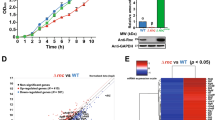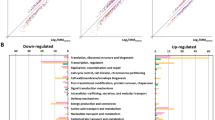Abstract
Salmonella species were the most deeply and extensively studied prokaryotes, which were used as useful prokaryotic models for the genetic analysis. Salmonella enterica serovar Typhi (S. Typhi) is the etiological agent of typhoid fever, a major health problem in developing countries. UhpB/UhpA couple is a member of two-component regulatory system. It is considered that UhpB/UhpA controls the expression of the transport protein UhpT, which enables the cell to acquire phosphorylated sugars from its environment that can be used as carbon and/or energy sources. In our previous microarray-based study, uhpA and uhpB were up-regulated in S. Typhi at early stage of an osmotic up-shift stress. To explore the functions of UhpA under this stress, we constructed an uhpA deletion mutant of S. Typhi, and compared the global transcriptional difference between the uhpA mutant strain and the wild-type strain upon the up-shift high osmotic stress by using a genomic DNA microarray. Only 21 genes showed significant expression differences in the uhpA mutant strain compared to the wild-type strain. Strikingly, these 21 genes were all down-regulated (twofold). Moreover, most of these genes were associated with sulfur assimilation pathways. The results were validated by quantitative real-time PCR. In this study, we first found that uhpA involved in regulating sulfur assimilation pathways upon up-shift high osmotic treatment for 30 min, which will further promote our insights into the regulator network of S. Typhi.


Similar content being viewed by others
References
Beenken KE, Dunman PM, McAleese F et al (2004) Global gene expression in Staphylococcus aureus biofilms. J Bacteriol 186:4665–4684
Deng W, Liou SR, Plunkett G III et al (2002) Salmonella enterica subsp. enterica serovar Typhi Ty2 complete genome information: http://www.ncbi.nlm.nih.gov/entrez/query.fcgi?db=genomeprj&cmd=Retrieve&dopt=Overview&list_uids=371
Everest P, Wain J, Roberts M et al (2001) The molecular mechanisms of severe typhoid fever. Trends Microbiol 9:316–320
House D, Bishop A, Parry C et al (2001) Typhoid fever: pathogenesis and disease. Curr Opin Infect Dis 14:573–578
Huang XX, Phung LV, Dejsirilert SR et al (2004) Cloning and characterization of the gene encoding the z66 antigen of Salmonella enterica serovar Typhi. FEMS Microbiol Lett 234:239–246
Huang XX, Xu HX, Xu SG et al (2007) Genomic oligo microarray analysis of global transcriptional expression by Salmonella enterica serovar Typhi during hyperosmotic stress. Int J Mol Sci 8:116–135
Island MD, Kadner RJ (1993) Interplay between the membrane-associated UhpB and UhpC regulatory proteins. J Bacterial 175:5028–5034
Island MD, Wei BY, Kadner RJ (1992) Structure and function of the uhp genes for the sugar phosphate transport system in Escherichia coli and Salmonella typhimurium. J Bacterial 174:2754–2762
Iwanicka-Nowicka R, Hryniewicz MM (1995) A new gene, cbl, encoding a member of the LysR family of transcriptional regulators belongs to Escherichia coli cys regulon. Gene 166:11–17
Jones BD, Falkow S (1996) Salmonellosis: host immune responses and bacterial virulence determinants. Annu Rev Immunol 14:533–561
Khan AQ, Zhao L, Hirose K et al (1998) Salmonella typhi rpoS mutant is less cytotoxic than the parent strain but survives inside resting THP-1 macrophages. FEMS Microbiol Lett 161:201–208
Kredich NM (1996) Biosynthesis of cysteine. In: Neidhardt FC, Curtiss R, Ingraham JL et al (eds) Escherichia coli and Salmonella: cellular and molecular biology. ASM Press, Washington, DC, pp 514–527
Luo L, Salunga RC, Guo H et al (1999) Gene expression profiles of laser-captured adjacent neuronal subtypes. Nat Med 5:117–122
Parkinson JS, Kofoid EC (1992) Communication modules in bacterial signaling proteins. Annu Rev Genet 26:71–112
Parry CM, Hien TT, Dougan G et al (2002) Review article: typhoid fever. N Engl J Med 347:1770–1782
Rychlik I, Barrow PA (2005) Salmonella stress management and its relevance to behavior during intestinal colonization and infection. FEMS Microbiol Rev 29:1021–1040
Sebastien P, Steffen P, Charles M et al (2006) Transcriptome of Salmonella enterica serovar Typhi within macrophages revealed through the selective capture of transcribed sequence. PNAS 103:1906–1911
Sheng XM, Huang XX, Mao LX et al (2009) Preparation of Salmonella enterica Serovar Typhi genomic DNA microarrays for gene expression profiling analysis. Prog Biochem Biophys 36:206–212
Stock AM, Robinson VL, Goudreau PN (2000) Two-component signal transduction. Annu Rev Biochem 69:183–215
Stock JB, Ninfa AJ, Stock AM (1989) Protein phosphorylation and regulation of adaptive responses in bacteria. Microbiol Rev 53:450–490
Talat AM, Hunter P, Johnston SA (2000) Genome-directed primers for selective labeling of bacterial transcripts for DNA microarray analysis. Nat Biotechnol 18:679–682
Tusher V, Tibshirani R, Chu C (2001) Significance analysis of microarrays applied to the ionizing radiation response. Proc Natl Acad Sci U S A 98:5116–5121
Van der Ploeg JR, Iwanicka-Nowicka R, Bykowski T et al (1999) The Escherichia coli ssuEADCB gene cluster is required for the utilization of sulfur from aliphatic sulfonates and is regulated by the transcriptional activator Cbl. J Biol Chem 41:29358–29365
Van der Ploeg JR, Iwanicka-Nowicka R, Kertesz MA et al (1997) Involvement of CysB and Cbl regulatory proteins in expression of the tauABCD operon and other sulfate starvation-inducible genes in Escherichia coli. J Bacteriol 179:7671–7678
Verhamme DT, Postma PW, Crielaard W et al (2002) Cooperativity in signal transfer through the Uhp system of Escherichia coli. J Bacteriol 184:4205–4210
Verhamme DT, Arents JC, Postma PW et al (2001) Glucose-6-phosphate-dependent phosphoryl flow through the Uhp two-component regulatory system. Microbiology 147:3345–3352
West AH, Stock AM (2001) Histidine kinases and response regulator proteins in two-component signaling systems. Trends Biochem Sci 26:369–376
Western LA, Kadner RJ (1988) Role of uhp genes in expression of the Escherichia coli sugar-phosphate transport system. J Bacterial 170:3375–3383
Wright JS, Kadner RJ (2001) The phosphoryl transfer domain of UhpB interacts with the response regulator UhpA. J Bacterial 183:3149–3159
Xu SG, Zhang HF, Sheng XM et al (2008) Transcriptional expression of fljB:z66, a flagellin gene located on a novel linear plasmid of salmonella enterica serovar Typhi under environmental stresses. New Microbiol 31:241–247
Acknowledgment
This study was supported by grants from National Key Technology R&D Program of China (No. 2006BAK02A15) and Natural Science Foundation for colleges and universities in Jiangsu Province (No. 1191270005).
Author information
Authors and Affiliations
Corresponding author
Electronic supplementary material
Below is the link to the electronic supplementary material.
Rights and permissions
About this article
Cite this article
Sheng, X., Huang, X., Li, J. et al. Regulation of Sulfur Assimilation Pathways in Salmonella enterica Serovar Typhi Upon Up-Shift High Osmotic Treatment: The Role of UhpA Revealed Through Transcriptome Profiling. Curr Microbiol 59, 628–635 (2009). https://doi.org/10.1007/s00284-009-9487-7
Received:
Revised:
Accepted:
Published:
Issue Date:
DOI: https://doi.org/10.1007/s00284-009-9487-7




